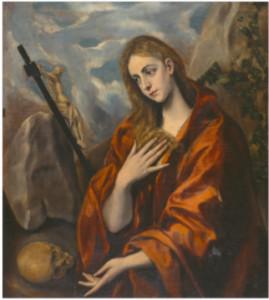'Penitent Magdalene with the Cross', by Doménikos Theotokópoulos “El Greco”
Work:Penitent Magdalene with the Cross, by Doménikos Theotokópoulos “El Greco” (1541-1614)
Data: C. 1585-1590 (?)
Technique: Oil on canvas
Dimensions:106 x 95 cm. Signed on the left below the skull in cursive Greek script: “doménikos theotokópoulos e’poíei”
Collection: Former collection of Santiago Rusiñol (1894). Museu Cau Ferrat
Inventory no.: 32,004
Description:
 The Magdalene was originally part of Pablo Bosch’s collection in Madrid and was purchased by Santiago Rusiñol in Paris on 28th January 1894 at Ignacio Zuloaga’s behest, with Laureà Barrau as middleman. It is a landmark work and was used by Catalan artists from the modernista movement to reappraise and honour the memory of the Cretan old master, who had been called “independent” because he “surrendered to the impulses of his natural inclinations”.
The Magdalene was originally part of Pablo Bosch’s collection in Madrid and was purchased by Santiago Rusiñol in Paris on 28th January 1894 at Ignacio Zuloaga’s behest, with Laureà Barrau as middleman. It is a landmark work and was used by Catalan artists from the modernista movement to reappraise and honour the memory of the Cretan old master, who had been called “independent” because he “surrendered to the impulses of his natural inclinations”.
The owner of the painting, Santiago Rusiñol, compared it with the work he purchased at the same time, Les llàgrimes de sant Pere (The Tears of Saint Peter), and described it thus: “The saint is painted in a different harmony; she is sweeter, more spread out on a bed of burnt-out colours, described in gentler words. Her eyes are big, very big, beneath her heavy brow; they are moist with affection and purple with pain; her nose is straight, her mouth turns up in two folds between reddish carmines; the neck is long and hidden by her hair, hinting at her hysterical and ailing body with its virginal delicacy and angles of suffering.”
Indeed, as can be deduced from the Catalan painter’s description, El Greco used a very different formula to portray this Mary Magdalene, which is the least Venetian of them all. She is a pensive figure, meditating by the crucifix, gesturing towards the skull with her left hand to show us how brief life is; she is a Magdalene who has found spiritual peace through repentance. It seems that prayer and penitence have regenerated the sinful woman to make her into a saint and, just like before, there are no tears on her face, but the difference lies in the fact that here she appears to have shed them all. There are no traces of her lust, nor do we see the pot of unguents. However, she retains her youth and outstanding beauty, which is now spiritualised; we cannot see her body which is covered by an austere vermillion cloak rendered by thick layers of paint: a magnificent piece of painting. This work by the painter from Candia is a Spanish variation on the theme, a new iconographic contribution. Although it refers to the remote Titianesque model, its influence is only shown in the colour and pictorial technique; it is devoid of the profane language which Theotokópoulos discovered in the city of the lagoons.
This excellent pictorial pedigree bears witness to the unmistakeable skill of Doménikos Greco; we can see his painstaking attention to detail in the skin tones, particularly the saint’s right hand and ear, which have been executed with great delicacy and produce a tactile feeling that is hinted at in the act of caressing the light brown mane of hair with its faint blond highlights. It is an outstanding work among the series of solitary saints produced by El Greco’s brush.
Critics do not agree on the date of the painting: Mayer (1926) dated it between 1582 and 1586. Camón Azanar (1950) said it was painted in 1590; Soehner (1957-1960) put it at a later date, 1600-1602; Wethey (1962) between 1585 and 1590; Gudiol (1971) between 1587 and 1597; Pita Andrade (1981) said it was painted around 1590; Álvarez Lopera (1993) dated it between 1587-1596; whereas the expos in Madrid (1982), Tokyo (1986-1987) and Paris (1987-1988) accepted the date proposed by Wethey, which is the one given here.
The Sitges painting is in more than acceptable condition, particularly if we bear in mind that it had undergone somewhat dubious restoration before Santiago Rusiñol purchased it. Some 50 years later, it underwent rigorous restoration, using exemplary techniques, by the then head of the workshop at the Museu d’Art de Catalunya.
Exhibitions:
Sitges, Temporary Display of Works by El Greco from Museums in Catalonia, June 1936.
Washington/ Madrid/ Toledo (Ohio)/ Dallas. El Greco in Toledo, 1982-1983.
Tokyo/Nara/ Aichi, El Greco Exhibition, 1986-1987.
Paris, From El Greco to Picasso, 1987-1988.
Barcelona, El Greco. His Reappraisal by Catalan Modernisme, 1996-1997.
Basic bibliography:
Álvarez Lopera, José: El Greco. La obra sencial. Madrid, 1993.
Camón Aznar, José: Dominico Greco 2 vol. 2nd ed. revised and expanded. Madrid, 1970.
Gudiol, José: Doménikos Theotokopoulos, El Greco, 1541-1614. Barcelona, 1971.
Mayer, August L.: Dominico Theothocopuli, El Greco. Kritisches und illustriertes
Verzeichnis des Gesamtwerkes. Munich, 1926.
Pita Andrada, José Manuel / Álvarez Lopera, José: El Greco. Madrid, Carroggio, 1985.
Author of the file: Maria Margarita Cuyàs


 Buy tickets
Buy tickets Buy tickets
Buy tickets


